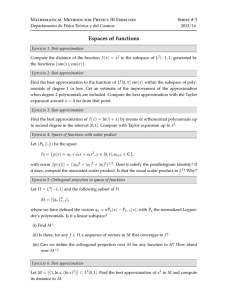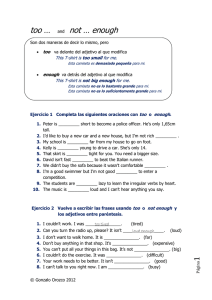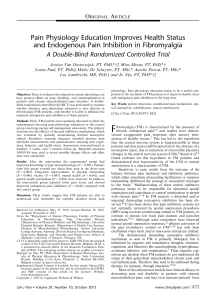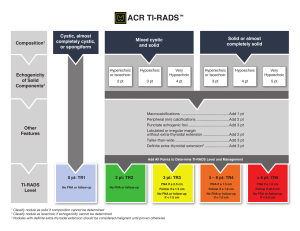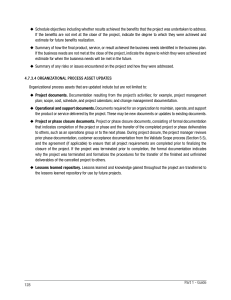Pág. 250 - Psicothema
Anuncio
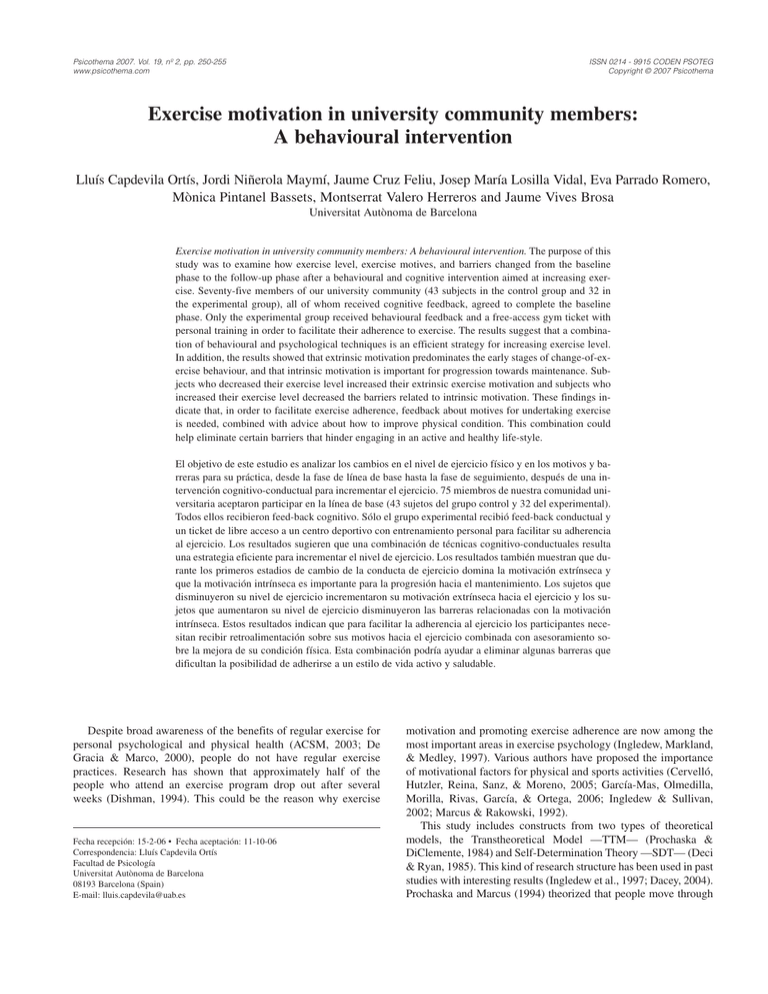
Psicothema 2007. Vol. 19, nº 2, pp. 250-255 www.psicothema.com ISSN 0214 - 9915 CODEN PSOTEG Copyright © 2007 Psicothema Exercise motivation in university community members: A behavioural intervention Lluís Capdevila Ortís, Jordi Niñerola Maymí, Jaume Cruz Feliu, Josep María Losilla Vidal, Eva Parrado Romero, Mònica Pintanel Bassets, Montserrat Valero Herreros and Jaume Vives Brosa Universitat Autònoma de Barcelona Exercise motivation in university community members: A behavioural intervention. The purpose of this study was to examine how exercise level, exercise motives, and barriers changed from the baseline phase to the follow-up phase after a behavioural and cognitive intervention aimed at increasing exercise. Seventy-five members of our university community (43 subjects in the control group and 32 in the experimental group), all of whom received cognitive feedback, agreed to complete the baseline phase. Only the experimental group received behavioural feedback and a free-access gym ticket with personal training in order to facilitate their adherence to exercise. The results suggest that a combination of behavioural and psychological techniques is an efficient strategy for increasing exercise level. In addition, the results showed that extrinsic motivation predominates the early stages of change-of-exercise behaviour, and that intrinsic motivation is important for progression towards maintenance. Subjects who decreased their exercise level increased their extrinsic exercise motivation and subjects who increased their exercise level decreased the barriers related to intrinsic motivation. These findings indicate that, in order to facilitate exercise adherence, feedback about motives for undertaking exercise is needed, combined with advice about how to improve physical condition. This combination could help eliminate certain barriers that hinder engaging in an active and healthy life-style. El objetivo de este estudio es analizar los cambios en el nivel de ejercicio físico y en los motivos y barreras para su práctica, desde la fase de línea de base hasta la fase de seguimiento, después de una intervención cognitivo-conductual para incrementar el ejercicio. 75 miembros de nuestra comunidad universitaria aceptaron participar en la línea de base (43 sujetos del grupo control y 32 del experimental). Todos ellos recibieron feed-back cognitivo. Sólo el grupo experimental recibió feed-back conductual y un ticket de libre acceso a un centro deportivo con entrenamiento personal para facilitar su adherencia al ejercicio. Los resultados sugieren que una combinación de técnicas cognitivo-conductuales resulta una estrategia eficiente para incrementar el nivel de ejercicio. Los resultados también muestran que durante los primeros estadios de cambio de la conducta de ejercicio domina la motivación extrínseca y que la motivación intrínseca es importante para la progresión hacia el mantenimiento. Los sujetos que disminuyeron su nivel de ejercicio incrementaron su motivación extrínseca hacia el ejercicio y los sujetos que aumentaron su nivel de ejercicio disminuyeron las barreras relacionadas con la motivación intrínseca. Estos resultados indican que para facilitar la adherencia al ejercicio los participantes necesitan recibir retroalimentación sobre sus motivos hacia el ejercicio combinada con asesoramiento sobre la mejora de su condición física. Esta combinación podría ayudar a eliminar algunas barreras que dificultan la posibilidad de adherirse a un estilo de vida activo y saludable. Despite broad awareness of the benefits of regular exercise for personal psychological and physical health (ACSM, 2003; De Gracia & Marco, 2000), people do not have regular exercise practices. Research has shown that approximately half of the people who attend an exercise program drop out after several weeks (Dishman, 1994). This could be the reason why exercise Fecha recepción: 15-2-06 • Fecha aceptación: 11-10-06 Correspondencia: Lluís Capdevila Ortís Facultad de Psicología Universitat Autònoma de Barcelona 08193 Barcelona (Spain) E-mail: [email protected] motivation and promoting exercise adherence are now among the most important areas in exercise psychology (Ingledew, Markland, & Medley, 1997). Various authors have proposed the importance of motivational factors for physical and sports activities (Cervelló, Hutzler, Reina, Sanz, & Moreno, 2005; García-Mas, Olmedilla, Morilla, Rivas, García, & Ortega, 2006; Ingledew & Sullivan, 2002; Marcus & Rakowski, 1992). This study includes constructs from two types of theoretical models, the Transtheoretical Model —TTM— (Prochaska & DiClemente, 1984) and Self-Determination Theory —SDT— (Deci & Ryan, 1985). This kind of research structure has been used in past studies with interesting results (Ingledew et al., 1997; Dacey, 2004). Prochaska and Marcus (1994) theorized that people move through EXERCISE MOTIVATION IN UNIVERSITY COMMUNITY MEMBERS: A BEHAVIOURAL INTERVENTION a series of separate stages of change (SOC) in order to restore their exercise habit: the evaluation of information and its relevance to their lives; making a commitment to take action; strengthening their attention to change; and eventually making progress toward their goal of adopting or altering a specific behaviour. Moreover, Prochaska (1994) argued that «progression from precontemplation to action is a function of approximately half of the standard deviation decrease in the cons of healthy behaviour». Researchers have applied this theory to other health-related behaviour such as smoking, healthy diet, condom use, drugs, etc. Doctors and psychologists have used this questionnaire widely and there are similar versions adapted to other health issues (USDHHS, 1999). Exercise motivations (Pros) and exercise barriers (Cons) have been identified as consistently discriminating against individuals at different stages of exercise behaviour (Jordan, Nigg, Norman, Rossi, & Benisovich, 2002). As a consequence of these studies, researchers created a five-item instrument to assess the stages of change in exercise behaviour (Reed, Velicer, Prochaska, Rossi, & Marcus, 1997), which classified people into one of the stages of TTM according to their exercise level. Decy and Ryan (1985) argued that extrinsic motivation can occasionally change into intrinsically motivated behaviour through the process of internalization. The motivational model proposed by SDT provides theoretical insight into the reasons people drop out of exercise, and allows an analysis to be made of the motivational processes involved in the exercise domain (Wilson & Rogers, 2004). In exercise research, certain studies have shown that intrinsic motivation is an important element for maintaining regular exercise behaviour, whereas extrinsic motivation is important in the early stages (Frederick & Ryan, 1993; Ingledew et al., 1997). In exercise research, Markland and Ingledew (1997) developed a reliable questionnaire to assess the extrinsic and intrinsic motivation of adults participating in moderate exercise; this was called Exercise Motivations Inventory 2 (EMI-2). Capdevila, Niñerola, and Pintanel (2004) validated EMI-2 in Spanish, in which it was called AMPEF (Autoinforme de Motivos para la Práctica de Ejercicio Físico - Exercise Motivation Questionnaire). Researchers have usually studied exercise barriers in specific situations or specific groups in very diverse forms. Ball, Crawford and Owen (2000) argued that the most significant barrier for obese Australians was their body-image perception and laziness in doing exercise. Amesty (2003) showed that barriers are related more to sport and exercise facilities at a community level and the sensation of personal security. Allison, Dwyer and Makin, (1999) found that for high-school students the lack of organization for combining studies and home obligations was the main barrier to exercise adherence. In the United States, research on exercise barriers demonstrated that access to sports equipment, the perceived safety of the neighbourhood and physical activity self-efficacy were the highest barriers in white girls, in comparison to African-American girls, who were less active than others (Motl, Dishman, Saunders, Dowda, Felton, & Ward, 2002). One of the previous methodological problems found was that there was no standardized questionnaire to assess barriers related to exercise. Researchers usually use specific dichotomies or multiple-choice questions in a section on motivation and adherence-to-exercise surveys. For this reason, Niñerola, Capdevila and Pintanel (2006) created and validated the ABPEF (Autoinforme de Barreras para la Práctica de Ejercicio Físico - Exercise Barriers questionnaire). 251 The aim of this study was to examine how exercise level, exercise motives and barriers differ among subjects according to their experimental condition. Subjects in the experimental group received a free-access gym pass, information on how to adhere to regular exercise and feed-back on their motives for and barriers to doing exercise. Subjects in the Control group received only feedback on their motives for and barriers to doing exercise. It was predicted that subjects who were in the experimental group would be associated with a higher exercise level, an increase in exercise motivation and a decrease in barriers, compared to subjects in the control group. Method Participants The study sample totalled 75 subjects, 37 males and 38 females (Mean age= 35.34, SD= 9.17 years). Initially, all members of the Universitat Autonoma de Barcelona (UAB-Spain) were invited to participate in this study via an e-mail that directed them through Internet to an electronic version of the stage of change five-item questionnaire (USDHHS, 1999). A total of 3897 subjects completed the electronic questionnaire and were classified into a stage of change for the exercise posited in the Transtheoretical Model. 1733 subjects who had been classified into at least the contemplation stage of change or preparation stage of change were therefore declared eligible for inclusion in the current study. 180 subjects were randomly selected, divided into two groups and invited to participate. Finally, a total of 75 subjects agreed to their participation in the baseline exercise protocol. The control group included 43 (Mean age= 35.81, SD= 9.62 years), 22 males and 21 females, and the experimental group included 32 subjects (Mean Age= 32.18, SD= 6.96 years), 15 males and 17 females. Measures A five-item algorithm was used to assess the stage of change for the exercise (Capdevila, 2005) —based on the Sample Physical Activity Questionnaire to Determine Stage of Change (USDHHS, 1999)—. In this instrument, respondents were asked to answer «yes» or «no» to a series of five questions related to their current exercise behaviour and future intentions to exercise. This questionnaire classifies the population into five stages according to the Transtheoretical Model: (1) Precontemplation - currently not doing exercise and not intending to start within the next six months; (2) Contemplation - currently not doing exercise but intending to start within the next six months; (3) Preparation doing exercise but not regularly; (4) Action - doing exercise but for less than 6 months; and (5) Maintenance - doing exercise for 6 months or more. Versions of this measure have been found to be both reliable and valid (Marcus & Simkin, 1993; Reed et al, 1997). Furthermore, subjects answered the AMPEF, the Spanish version of EMI-2, which assesses motives for exercise participation (Capdevila, Niñerola, & Pintanel, 2004). The scales of AMPEF were (in alphabetical order) Affiliation, Challenge (i.e., personal challenge), Competition, Enjoyment (of the activity itself), Health Pressures (i.e., pressures arising from specific medical advice or a specific medical condition), Ill-health avoidance and positive health (i.e., avoidance of health problems), Nimbleness, Social Recognition, Strength and Endurance, and Weight Management 252 LLUÍS CAPDEVILA ORTÍS, JORDI NIÑEROLA MAYMÍ, JAUME CRUZ FELIU, JOSEP MARÍA LOSILLA VIDAL, EVA PARRADO ROMERO, MÒNICA PINTANEL BASSETS, MONTSERRAT VALERO HERREROS AND JAUME VIVES BROSA and Appearance (i.e., physical appearance). Furthermore, subjects also answered the ABPEF. a 17-item questionnaire that assesses specific barriers in exercise in relation to four scales: Body Image and Social Physique Anxiety, Environment/Sports facilities, Home Obligations, Fatigue (Niñerola, Capdevila, & Pintanel, 2006). Procedure Each subject completed the baseline phase between four and six months after the electronic questionnaire was completed. In this phase, all participants individually visited the UAB’s Sport Psychology Laboratory to assess the questionnaires described previously. All subjects received cognitive feed-back on their results and an exercise motivation profile once their AMPEF and ABPEF results were available. A member of the research team explained and informed each subject on their profile and suggested strategies to overcome barriers. Additionally, the experimental group received behavioural and physical advice aimed at improving their level of exercise over the following months. The researchers gave the experimental group subjects weekly behavioural advisory sessions and a gym ticket which included free-access to the university gym throughout the study. This free-access included personal training, which was given by a gym monitor in order to facilitate subjects’ exercise adherence. This personal training taught subjects how to improve their physical condition and flexibility. Finally, 32 subjects (19 males and 13 females) returned to the laboratory to complete the follow-up stage between 2 and 4 months after the baseline phase was completed, and answered the same questionnaires as in the baseline phase. This study received ethical approval from our university’s review committee. All subjects in the initial sample were invited to participate in a research project concerned with health. Before the baseline questionnaires, all participants indicated their willingness to participate and provided informed consent. Results Descriptive statistics from the AMPEF and ABPEF are presented in tables 1 and 2. Correlations between baseline and follow-up scores in AMPEF and ABPEF were all positive and significant (See tables 1 and 2). The poorest AMPEF correlation was Challenge (r= .560; p= .002); for ABPEF, this was Home Obligations (r= .456; p= 0.13). The highest AMPEF correlations were Weight Management and Appearance (r= .899; p<.001); in ABPEF these were Body Image and Social Physique Anxiety (r= Table 1 The values represent means, standards deviations and Pearson correlations between baseline and follow-up of AMPEF total score and factors AMPEF factors Baseline mean± SD Data analysis was performed using SPSS (v.14.0 SPSS Inc., Chicago). A repeated measures ANOVA was carried out to compare the two groups on exercise motives and barrier scales between the two phases of the study. Pearson correlations were calculated to relate baseline and follow-up scores. Additionally, a Chi square test was undertaken, also to compare percentages between the two phases. All tests were conducted at the 5% probability level. Correlation baseline/ Follow-up Affiliation 4.20±2.76 4.25±2.23 r= .808 (p<.001) Challenge 3.75±2.80 3.79±2.40 r=.560 (p=.002) Competition 2.29±2.25 2.82±2.40 r=.762 (p<.001) Enjoyment 7.09±1.69 7.21±1.74 r=.838 (p<.001) Health Pressures 8.67±3.64 3.17±2.14 r=.645 (p<.001) Ill-Health avoidance and positive health 8.30±1.39 8.35±1.31 r=.766 (p<.001) Nimbleness 7.19±2.36 7.42±1.79 r=.631 (p<.001) Weight Management and Appearance 4.90±2.63 5.52±2.35 r=.899 (p<.001) Social Recognition 4.75±1.09 5.25±1.60 r=.590 (p=.001) Strength and Endurance 6.85±3.00 7.92±2.44 r=.666 (p<.001) TOTAL SCORE 5.19±1.10 5.53±1.06 r=.639 (p<.001) Table 2 The values represent means, standards deviations and correlations between baseline and follow-up of ABPEF total score and factors ABPEF factors Data analysis Follow-up mean± SD Body Image and Social Physique Anxiety Baseline mean± SD Follow-up mean± SD Correlation baseline/ Follow-up r=.895 (p<.001) 0.94 ±1.42 1.16±1.75 Environment/Sports Facilities 1.5±1.66 1.32±1.35 r=.642 (p<.001) Home Obligations 6.68±2.22 6.16±2.61 r=.456 (p= .013) Fatigue 3.13±1.96 3.33±2.032 r=.508 (p= .005) TOTAL SCORE 3.06±1.24 2.99±1.38 r=.586 (p= .001) Table 3 The values represent the number of subjects and percentage in every stage of change STAGE OF CHANGE Phase / Group Precontemplation Contemplation Preparation Action Maintenance Total Baseline Male Female Total 2 (5.4%) 3 (7.9%) 5 (6.7%) 17 (45.9%) 12 (31.6%) 29 (38.7%) 12 (32.4%) 11 (28.9%) 23 (30.7%) 3 (8.1%) 4 (10.5%) 7 (9.3%) 3 (8.1%) 8 (21.1%) 11 (14.7%) 37(100%) 38 (100%) 75 (100%) Follow-Up Male Female Total 3 (15,8%) 1 (7.7%) 4 (12.5%) 5 (26.3%) 2 (15.4%) 7 (21.9%) 6 (31.6%) 4 (30.8%) 10 (31.3%) 2 (10.5%) 3 (23.1%) 5 (15.6%) 3(15.8%) 2 (15.4%) 7 (21,9%) 19 (100%) 13 (100%) 32(100%) 253 EXERCISE MOTIVATION IN UNIVERSITY COMMUNITY MEMBERS: A BEHAVIOURAL INTERVENTION intervention has been successful or not. In our study, at the baseline step, more than a quarter of the sample (30.7 %) fell into a category other than contemplation or action, which were the categories of the sample during the initial phase immediately prior to intervention in order to increase exercise behaviour. This phenomenon might be due to participants’ involvement in a study related to exercise behaviour and health, which entails feed-back on their exercise level while answering the questionnaire so as to determine stage of change. In spite of this hypothesis, there are many non-controlled variables that can be involved in this change during the considerable period of time between the initial questionnaire and the baseline. It might be of interest to carry out future studies of more-detailed character into the relation between exercise behaviour and the 7 6 5 Competition Score .895; p<.001). All correlations between AMPEF and ABPEF factors according to their experimental condition are shown in tables 1 and 2. An alpha level of .05 was used for all statistical tests. Of the 75 participants who agreed to participate in the baseline study, 6.7% were in precontemplation, 38.7% in contemplation, 30.7% in preparation, 9.3% in action and 14.7% in maintenance. More detailed data on stage of change, experimental condition and gender are shown in table 3. 32 subjects (19 males and 13 females) from 75 participants consented to return in order to complete a follow-up questionnaire; 43 declined. Both groups maintained the original percentage of subjects (the Chi square test was not statistically significant). 43.8% of these subjects were in an inferior stage of change (SOC), while 56.2% had the same or superior SOC (X?= 3,831; p= .056). In the control group, the percentage of subjects in an inferior SOC was higher than that in the experimental group, whose members were mainly at the same stage or superior. The evident differences were evaluated inferentially via a series of ANOVAs (2X2) to compare both groups in their exercise motives and barrier scales in two laboratory sessions. The interaction effect for group and session was statistically significant for exercise motives (Total AMPEF score) [F(1. 30)= 4.844; p= .037] (see figure 1) and the competition factor of AMPEF [F(1. 30)= 4.501; p= 0.44], (see figure 2) and fatigue factor of ABPEF [F(1. 30)= 4.318; p= .047] (see figure 3). There were statistically significant differences in the affiliation factor of AMPEF [F(1. 30)= 4.735; p= .039] and in the ABPEF total score [F(1. 30)= 5.152; p= .031] between both groups, independently of the session (see tables 1 and 2). 4 3 Control 2 Experimental 1 0 Discussion BASELINE It is necessary to develop strategies useful to the evaluation of the quality of physical-activity programs (Morales, HernándezMendo, & Blanco, 2005). In this sense, the model of Stages of Change allows us to analyze the evolution in exercise behaviour for a sample or community, and determines whether a given FOLLOW-UP EXPERIMENTAL STEP Figure 2. Differences between experimental and control group in the baseline and follow-up according to the AMPEF competition factor. The interaction effect for group and session was statistically significant [F(1,30)= 4.501; p= .044] 7 7 6 6 Control 5 Experimental Fatigue Score AMPEF Total Score 5 4 3 4 Control 3 2 2 1 1 Experimental 0 0 FOLLOW-UP BASELINE EXPERIMENTAL STEP Figure 1. Differences between experimental and control group in the baseline and follow-up according to the AMPEF total score. The interaction effect for group and session was statistically significant [F(1,30)= 4.844; p= .037] FOLLOW-UP BASELINE EXPERIMENTAL STEP Figure 3. Differences between experimental and control group in the baseline and follow-up according to the ABPEF fatigue factor. The interaction effect for group and session was statistically significant [F(1,30)= 4.318; p= .047] 254 LLUÍS CAPDEVILA ORTÍS, JORDI NIÑEROLA MAYMÍ, JAUME CRUZ FELIU, JOSEP MARÍA LOSILLA VIDAL, EVA PARRADO ROMERO, MÒNICA PINTANEL BASSETS, MONTSERRAT VALERO HERREROS AND JAUME VIVES BROSA effects on subjects involved in a research project in which they obtain feed-back on their exercise level. Similarly, in the follow-up phase, the data suggest that facilitating gym access and personal training to the university community is an interesting strategy by which to improve members’ exercise level. Subjects in the experimental group increased or maintained their exercise level, whilst subjects in the control group fell into a stage of change that was lower in the follow-up than in the baseline. In addition, researchers found that Pearson correlations between factors in the exercise-motives questionnaire were higher than in the barrier questionnaires; this suggests that exercise motives are more stable and more related to life-style than are barriers, which are more related to the individual’s current situation. This could corroborate our previous studies, which came to the same conclusion (Capdevila et al., 2004). Subjects in the control group had higher exercise motives for exercise motivation in general, and for competition and affiliation in particular. Subjects in the experimental group had fewer barriers than the control group in the questionnaire’s total score and in the fatigue factor. These findings in exercise motives can be readily explained by the feed-back effect of questionnaire scores and suggestions for improving exercise level. On the one hand, subjects who returned to complete the follow-up knew their baseline results and had received certain recommendations for increasing their exercise level; it appears that this is a good strategy for increasing such subjects’ extrinsic motivation towards exercise. This is also of relevance to becoming active, but is not enough in itself to implement regular exercise behaviour. On the other hand, subjects who had the same feed-back and the same suggestions and who had received a free-access gym pass combined with personal exercise training reduced their exercise barriers, most particulalrly those related to physical training conditions and fatigue. Curiously, in a study into motives for doing sport carried out with Spanish schoolchildren (hence active, due to Physical Activity being scheduled as a school subject), researchers found that improvement in personal physical condition was one of the main motives (Cecchini, Méndez, & Muñiz, 2002). Taken as a whole, the results suggest that level of physical condition may be involved in this process, but further research is needed that includes physiological parameters such as heart-rate variability (Sandercock, Bromley, & Brodie, 2005), body mass index (Heyward, 2004), etc., in comparison to psychological and quality-of-life parameters (Krawczynski & Olszewski, 2000) in order to reach more solid conclusions. These results are in line with those of Ingledew et al. (1997), who suggest that extrinsic motivation dominates the early stages of exercise-change behaviour, whereas intrinsic motivation is important for progression to maintenance. Our results indicate that subjects who decrease their exercise level (control group) increase their extrinsic exercise motivation (Affiliation and Competition), whilst subjects who increase their exercise level (experimental group) decrease barriers related to intrinsic motivation, such as fatigue. The explanation might be that subjects who are not extrinsically motivated to do exercise but nevertheless carry out some form of regular exercise, are probably in better physical condition. Positive reinforcement works as an exercise adherence behaviour and, consequently, these subjects have a lower perception of fatigue, even if their exercise motives remain stable or decrease. Moreover, subjects who present higher levels of extrinsic motivation, but do not do regular exercise, have nevertheless probably tried to do exercise, but could not overcome their exercise barriers, particularly fatigue. These findings are similar to those of Gorely and Bruce (2000), who noted that rising exercise motives and exercise barriers in the control group could indicate that barriers have critical levels preventing or inhibiting change; once these are overcome, however, change may become easier. There are certain methodological limitations to our study. It was drawn from a population of subjects who answered voluntarily. Consequently, a subject’s willingness to participate in the study may reflect specific attitudes toward physical activity. To summarise, our results indicate that —in order to facilitate exercise adherence— feed-back is needed on motives for undertaking exercise, combined with advice about how to improve physical condition. This combination could help eliminate certain barriers that obstruct the possibility of engaging in an active and healthy life-style. In accordance with these results, it would be interesting to review the kind of extrinsic motivation that is related to exercise adherence in early stages. It would appear that cognitive and behavioural intervention should be aimed more at decreasing barriers related to extrinsic motivation than at increasing motives for taking exercise, which are usually more stable than barriers seem to be. Acknowledgements This research was supported by I+D SEJ2005-05113, and BSO2003-04301 from the Spanish Government, 01/UPB31/04 grant from the Consejo Superior de Deportes and SGR200500318 from the Catalan government. References ACSM (2003). ACSM Fitness Book. Champaign: Human Kinetics. Allison, K.R., Dwyer, J.J.M., & Makin, S. (1999). Perceived barriers to physical activity among high school students. Preventive Medicine, 28, 608-615. Amesty, S.C. (2003). Barriers to physical activity in the Hispanic community. Journal of Public Health Policy, 24, 41-58. Ball, K., Crawford, D., & Owen, N. (2000). Too fat to exercise? Obesity as a barrier to physical activity. Australian and New Zealand Journal of Public Health, 24, 331-333. Capdevila, L. (2005). Actividad física y estilo de vida saludable. Girona: Documenta Universitaria. Capdevila, L., Niñerola, J., & Pintanel, M. (2004). Motivación y actividad física: el autoinforme de motivos para la práctica de ejercicio físico (AMPEF). Revista de Psicología del Deporte, 13, 55-74. Cecchini, J.A., Méndez, A., & Muñiz,J. (2002). Motives for practicing sport in Spanish schoolchildren. Psicothema, 14(3), 523-531. Cervelló, E., Hutzler, Y., Reina, R., Sanz, D., & Moreno, J.A. (2005). Goal orientations, contextual and situational motivational climate and competition goal involvement in spanish athletes with cerebral palsy. Psicothema, 17(4), 633-638. EXERCISE MOTIVATION IN UNIVERSITY COMMUNITY MEMBERS: A BEHAVIOURAL INTERVENTION Dacey, M.L. (2004). Exercise Motivations Inventory-revised (EMI-2) applied to older adults: Exploratory factor analysis. Research Quarterly for Exercise and Sport, 75(1), Axxiv-Axxvi. Deci, E.L., & Ryan, R.M. (1985). The general causality orientations scale: Self-determination in personality. Journal of Research in Personality, 19(2), 109-134. De Gracia, M., & Marco, M. (2000). Efectos psicológicos de la actividad física en personas mayors. Psicothema, 12(2), 285-292. Dishman, R.K. (1994). Consensus, problems and prospects. In Dishman, R.K. (ed.): Advances in Exercise Adherence (pp. 1-29). Champaign, Il: Human Kinetics. Frederick, C., & Ryan, R. (1993). Differences in motivation for sport and exercise and their relations with participation and mental health. Journal of Sport Behavior, 16(3), 124-146. García-Mas, A., Olmedilla, A., Morilla, M., Rivas, C., García, E., & Ortega, E. (2006). Un nuevo modelo de cooperación deportiva y su evaluación mediante un cuestionario. Psicothema, 18(3), 425-432. Gorely, T., & Bruce, D. (2000). A 6-month investigation of exercise adoption from the contemplation stage of the transtheoretical model. Psychology of Sport and Exercise Psychology, 2, 89-101. Heyward, V. (2004). Applied Body Composition assessment. Champaign,Il: Human Kinetics. Ingledew, D., Markland, D., & Medley, A.R. (1997). Exercise motives and stages of change. Journal of Health Psychology, 3, 477-489. Ingledew, D.K., & Sullivan, G. (2002). Effects of body mass and body image on exercise motives in adolescence. Psychology of Sport and Exercise, 3, 323-338. Jordan, P.J., Nigg, C.R., Norman, G.J., Rossi, J.S., & Benisovich, S.V. (2002). Does the trenstheoritical model need an attitude adjustment? Integrating attitude with decisional balance as predictors of stage of change for exercise. Psychology of Sport and Exercise, 3, 65-83. Krawczynski, M., & Olszewski, H. (2000). Psychological well-being associated with a physical activity programme for persons over 60 years old. Psychology of Sport and Exercise Psychology, 1, 57-63. 255 Marcus, B.H., Rakowski, W., & Rossi, J.S. (1992). Assessing Motivational Readiness and Decision-Making for Exercise. Health Psychology, 11, 257-261. Marcus, B.H., & Simkin, L.R. (1993). The stages of exercise behaviour. Journal of sports Medicine and Physical Fitness, 33, 83-88. Markland, D., & Ingledew, D.K. (1997). The measurement of exercise motives: Factorial validity and invariance across gender of a revised exercise motivations inventory. British Journal of Health Psychology, 2, 361-376. Morales, V., Hernández-Mendo, A., & Blanco, A. (2005). Evaluación de la calidad en los programas de actividad física. Psicothema, 17(2), 311-317. Motl, R.W., Dishman, R.K., Saunders, R.P., Dowda, M., Felton, G., Ward, D.S., & Pate, R.R. (2002). Examining social-cognitive determinants of intention and physical activity among black and white adolescent girls using structural equation modeling. Health Psychology, 21, 459-467. Niñerola, J., Capdevila, L., & Pintanel, M. (2006). Barreras percibidas en el ejericico físico: el autoinforme de barreras para la práctica de ejercicio físico. Revista de Psicología del Deporte, 15(1), 53-69. Prochaska, J.O., & Marcus, B.H. (1994). The transtheoretical model: Applications to exercise. In R.K. Dishman (ed.): Advances in exercise adherence (pp. 161-180). Champaign, IL.: Human Kinetics.. Prochaska, J.O., & DiClemente, C.C. (1984). Self change processes, self efficacy and decisional balance across five stages of smoking cessation. Progress in Clinical and Biological Research, 156, 131-140. Reed, G., Velicer, W.F., Prochaska, J.O., Rossi, J.S., & Marcus, B.H. (1997). What makes a good staging algorithm: examples from regular exercise. American Journal of Health Promotion, 12, 72-74. Sandercock, G.R., Bromley, P.D., & Brodie, D.A. (2005). Effects of exercise on heart rate variability: inferences from meta-analysis. Medicine and Science in Sports and Exercise, 37, 433-439. USDHHS (1999). Promoting Physical Activity: A Guide for Community Action. Champaign, IL: Human Kinetics. Wilson, P.M., & Rodgers, W.M. (2004). The relationship between perceived autonomy support, exercise regulations and behavioural intentions in women. Psychology of Sport and Exercise, 5, 229-242.
